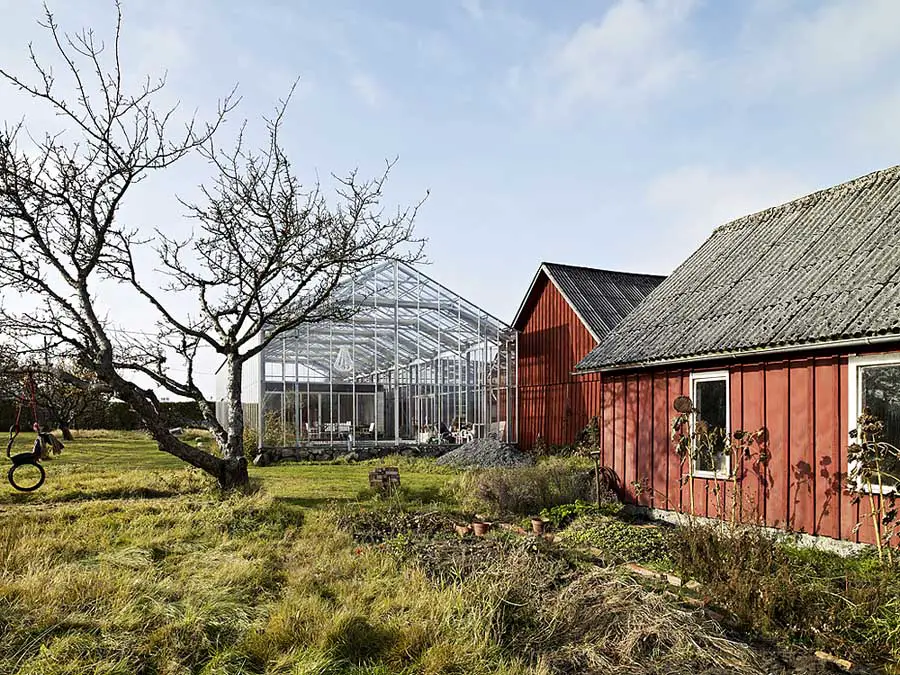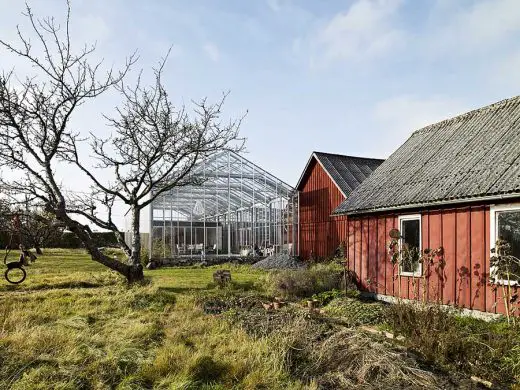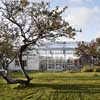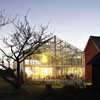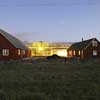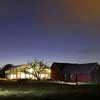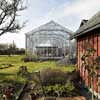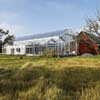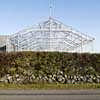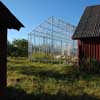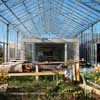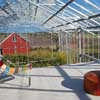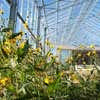Swedish Glass House, Träslövsläge Home, Property Sweden, Building, Images, Arkitekter, Photos
Glass House Sweden : Träslövsläge Property
Swedish residential building – design by Unit Arkitektur AB
21 Oct 2010
Glass House Träslövsläge
Architects: Unit Arkitektur AB
This residential project is not about form. It is about creating something that Sweden can´t offer – a nice climate! It has been verified that the space inside the glass house has the same climate as Sevilla in southern Spain.
In Träslövsläge just south of Varberg on the Swedish west coast Karin and Sven-Olav acquired a parcel of farmland. This property is located along an old village street with a vast open field behind. In addition to the old traditional main building a large barn and a smaller cottage are situated on the plot.
To the south there is an extensive orchard with a rich variety of trees. The buildings are placed in parallel on both sides of a courtyard whereas the traditional farm typology of this rural area dictates buildings to be placed on three sides of the yard.
Since the main building was small and in poor condition the growing family needed more space. In addition to this a large glassed entrance was also required.
The solution was to frame the courtyard with a 250m2 greenhouse and place a smaller 70m2 building inside. In this way the view of the orchard was saved; you see it through the glass when you enter the courtyard from the street. The total building cost equalled that of a 100m2 house; the difference in size of the indoor space corresponds to a normal living room.
So instead of 30m2 living room in a conventional house they got 150m2 of living space in the glazed structure. The greenhouse was built out of standard components and erected by a separate contractor.
The plan was reorganized so that the existing main building houses the bedrooms in order to avoid complicated technical installations in an old building. Another reason for this was the ability to lower the room temperature in these spaces to reduce heat loss from the poorly insulated house. The new house takes care of all the technology-intensive functions such as laundry, bathroom and kitchen. On the roof an Arabian Nights Terrace with North African climate is arranged.
The old building was carefully renovated – both interior and exterior – in accordance with the clients. Floor heating is installed in both buildings. The new building has a concrete slab foundation with a surface of pigmented smooth cast concrete. Generally construction materials with high thermal inertia were selected to counteract temperature fluctuations.
Walls are made up of solid light-weight concrete blocks with gypsum plaster on the inside. The roof consists of prefabricated Leca* beams with 100mm hard insulation on top. Topmost is a pressure distributing walkable 30mm layer of concrete.
The greenhouse is built with standard components, including climate controlling technology such as automatic vents in the roof ridge and shading textiles with reflective aluminium coating. The ventilation and temperature is controlled by a computer. To avoid overheating in summer the inner house is supplied with pre-cooled air from ducts buried in the ground.
During the cold season the same ducts help to pre-heat the fresh air and lower the need for additional heating. In the glazed space there are two climate zones, one at ground level and one – markedly warmer – in the terrace on the roof.
The project has no definite completion date in the traditional sense that project images are taken before the family moves in. On the contrary there has been a gradual realization process going on since 2006 where the garden is prioritized.
*Leca is an abbreviation for Light Expanded Clay Aggregate – a light building block with beneficial thermal insulation properties.
Techno
Understanding the workings of light and energy is fundamental to knowing how a greenhouse works. A greenhouse – as well as our whole atmosphere – is heated by energy radiation emitted by the sun. Half of the energy is in the visible light spectrum and half in wavelengths not visible to the human eye.
The energy that radiates through our atmosphere and through the glass of a greenhouse has a spectral composition that is produced by a source several thousands degrees hot – our sun. Through the properties of the glass you can control the amount of heat and visible light to be filtered into the greenhouse. Once the energy has entered the greenhouse it is partly absorbed and converted to heat radiation of a very different spectral composition than solar radiation.
Also this can be controlled with glass properties, ie. you can choose to slow the heat radiating out of the building or not. This is determined by the glass emission rates. For an ordinary clear 4mm float glass that is used in this project ε= 0.84 (about 4.4 W /m² K) and if you use a low emission glass at ε= 0.04 (about 0.2 W / m² K) you will capture the heat more effectively.
Regardless the specifications of the glass the heat loss is slowed by the greenhouse to create a warmer and – in the absence of a shading system – more fluctuating inland climate. It is also true that the climate is governed by the size of the greenhouse; incoming solar energy is squared with increasing size while the enclosed air mass increases almost cubically (depending on height).
This means that temperature fluctuations will be less dramatic in a larger greenhouse. In this project the potential overheating of the inside air is regulated in three ways; through manual opening of sliding doors, by the motorized textile shading controlled manually and by opening the vents along the ridge of the roof. These are programmed to be opened automatically at a specified maximum temperature.
The Glass House in Träslövsläge has been the subject of a masters degree work that was divided into two theses. In 2007 Louise Lilja logged temperature and humidity in her thesis for Angela Sasic Kalagasidis at Chalmers University of Technology. The purpose was to study the climate created in a glass house, and initial calculations were made to lay a foundation for a theoretical model of the project.
Then Lena Wallin used the data to construct and evaluate a theoretical model of the building in the analysis software IBPT (International Building Physics Toolbox). Once the theoretical model is verified you can use it to simulate the climate in greenhouses of different sizes.
With a functioning system of shading the climate created in the Glass House is equivalent to that of Sevilla or Ankara, ie. an inland climate around latitude 40˚ N. This means that with a little sunshine in January you can sit down to have your coffee wearing t-shirt! Even in Sweden.
Glass House Sweden – Building Information
Architects: Unit Arkitektur AB (unitark.se)
Location: Träslövsläge, Sweden
Design Principal: Mikael Frej + Klas Moberg
Project Architects: Frans Magnusson
Client: Karin and Sven-Olav
Floor area: 250 sqm (Glass House) 70 sqm (House inside Glass House)
Project year: 2006-11
Photographs: Krister Engström (www.kristerengstrom.com), Unit Arkitektur
Glass House Sweden images / information from Unit Arkitektur
Location: Träslövsläge, Sweden
Architecture in Sweden
Swedish Architecture Designs – chronological list
Architecture Walking Tours by e-architect
Other Swedish house designs by Unit Arkitektur:
Swedish Architecture – Selection
Archipelago House, Stockholm archipelago
Tham & Videgård Hansson Architects
Swedish house
Lidingo houses
Tham & Videgård Hansson Architects
Lidingo house Sweden
Albano University Campus
Christensen&Co Arkitekter
Albano University Campus Stockholm
Comments / photos for the Swedish Glass House page welcome

